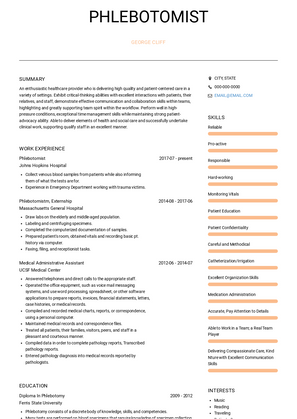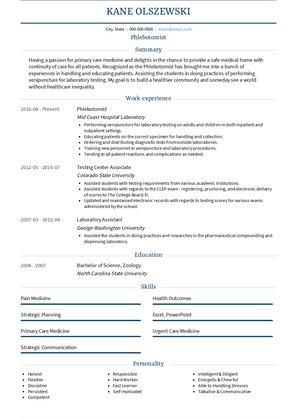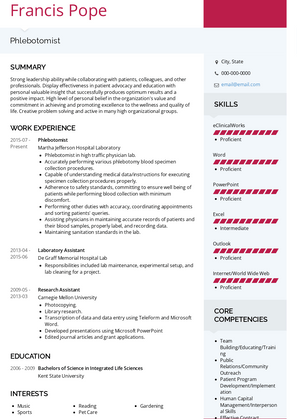Phlebotomist Resume Examples and Templates for 2022
Discover our complete guide and selection of Phlebotomist resume examples to use to create your own resume with our easy-to-use resume builder. Below you'll find our how-to section that will guide you through each section of a Phlebotomist resume.



Phlebotomist Resume Examples and Templates for 2022
If you have an interest in science, enjoy helping people, and, most importantly, don’t have a problem with seeing blood every day, you might consider a career as a phlebotomist! The US Department of Labor estimates that phlebotomist jobs are set to grow by 17% within the next decade, which means phlebotomist jobs will be in high demand. If you’d like to understand what it means to be a phlebotomist, or if you’re looking for phlebotomist resume samples and examples, you’ve come to the right place!
Of course, if you’re looking to secure a job as a phlebotomist, you’ll first have to create a resume that stands out from the rest. Thankfully, the VisualCV team is here to help you every step of the way.
Note: Leverage AI to level-up your resume - Try our AI Resume Builder
What is a Phlebotomist?
Phlebotomists are lab technicians that specialize in the practice of taking and analyzing blood samples from patients. If you’ve ever had a blood test done, it’s very likely that a phlebotomist was responsible for drawing your blood and preparing it for testing.
To be a good phlebotomist, you need to be extremely comfortable with seeing blood – if the idea makes you woozy, phlebotomy is definitely not the career for you! Beyond the training and qualifications necessary to become a phlebotomist, you should also be the type of person interested in helping others. “Bed-side manner” is important in any medical career. You’ll often be responsible for providing a service to patients who are already uncomfortable, sick, or in pain. Many people also have phobias of blood or getting their blood drawn, meaning you’ll need to provide comfort to help put them more at ease.
How to Write a Phlebotomist Resume
To write a phlebotomist resume, think about your training first and foremost. Whether you’re applying as a new graduate or as someone with years of experience, keep in mind that hiring managers are looking for clear answers to one main question: are you qualified to perform the tasks required of a phlebotomist?
In general, your phlebotomist resume should contain the following:
- A summary
- Your experience
- Your Education
- Your skills, including any professional certifications
The Best Format for a Phlebotomist Resume
Because phlebotomists need specific medical training in order to perform the duties of the job, your phlebotomist resume should highlight your education and training. If you’re seeking your first phlebotomist job, or if you don’t have much other dental assistant experience, you should make sure to clearly state your education and any additional certifications you hold. When you select your professionally designed phlebotomist resume template with VisualCV, your education, certifications, and experience can take center stage.
3 Phlebotomist Resume Summary Examples
Your headline should be short and to the point. This is the very first thing a recruiter will see, so make sure you’re putting your absolute best foot forward. Highlight your level of experience if you aren’t applying for entry-level positions, or your recent academic accomplishment if you’re a new graduate. Make sure to read the job description carefully and adjust your resume to fit it -- as long as what you’re saying is true, of course! In order to become a phlebotomist, you’ll have to prove one main thing – are you qualified to perform the required tasks of a phlebotomist? Phlebotomists embark on highly specialized education and training, as well as work placements and rigorous exams. Make sure that your phlebotomist resume clearly lays out all of your qualifications.
Many recruiters and companies now use Applicant Tracking Systems to automate and streamline the recruitment process. While this is a great benefit for companies, some applicants have been met with the frustration of their resumes not ever being seen by a real person -- if the resume doesn’t get past the ATS software, it’s usually discarded. Thankfully, VisualCV’s resume templates have been specifically designed to beat applicant tracking systems, making your phlebotomist resume much more likely to make it in front of the right person.
The Wrong Way to Write a Phlebotomist Resume Summary
Your summary shouldn’t be too wordy or personal – that’s what your cover letter is for! This first step in your dental assistant resume exists to give hiring managers a brief glimpse into your personality and experience. Not all hiring managers agree that a resume summary is necessary, but if your resume summary is clear, to the point, and hones in on what the job description is asking for, include it!
DON’T Do This
- When I was a little boy, I wanted to be a nurse because I watched them help my grandfather in the hospital. But then when I got older I decided I wanted to specialize more, so I became a phlebotomist!
Phlebotomist Resume Summary Sample
Certified phlebotomist trained in providing services to high-risk groups, obtaining blood samples through venipuncture and assisting with patient care.
Professional Summary for a Phlebotomist Resume
Certified phlebotomist with six years of experience preparing blood-collecting equippment, drawing blood through venipuncutre, and providing a high quality of care to local hospital patients.
Phlebotomist Resume Summary Example
Certified phlebotomist with 10 years of experience, specializing in providing a high quality of care to pediactric patients.
Do You Need a Phlebotomist Resume Objective?
Many people think resume objectives are a requirement for each and every phlebotomist resume they write. However, phlebotomist resume objectives are only recommended for people looking to transition into a new role, or for people looking for an entry-level phlebotomist position.
Phlebotomist Resume Objective Example
Recent graduate certified phlebotomist looking to use my training in venipuncture and patient care to secure a hospital phlebotomist position.
How to Describe Your Experience On Your Phlebotomist Resume
This is where you can really start bragging. Alison Green, author of Ask a Manager, highlights the single biggest resume mistake she saw in her time as a hiring manager: “Writing a resume that reads like a series of job descriptions.”
“The bullet points they use to describe what they did for each job just list activities and read like a job description for the role might,” she says. “For example, ‘edit documents,’ ‘collect data,’ or ‘manage website.’”
While writing the experience section of your phlebotomist resume, focus on what you accomplished at each position.
Certified Phlebotomist, City Hospital | 2015-2021
- Obtained blood samples for testing and transfusion through venipuncture for upwards of 150 patients per day
- Prepared, maintained, and accounted for blood-drawing equipment to ensure health and safety best practices while working with high-risk individuals and children
- Collaborated with patients and healthcare providers to provide a high quality of care
A hiring manager will be looking for the facts. What did you do at your previous jobs that made you stand out? For which projects did you receive the most praise? Providing tangible facts shows hiring managers that you have the potential to do the same at your next job.
A Bad Phlebotomist Job Description on a Resume
Consider the following entry.
Certified Phlebotomist, City Hospital | 2015-2021
- Obtained blood samples
- Cared for blood-drawing equipment
- Collaborated with patients and healthcare providers
This entry focuses on responsibilities you had at a previous job, but doesn’t describe what you achieved there. Hiring managers will likely already understand the types of tasks you performed at previous jobs. Your goal is to show them how good you are at performing those tasks!
How to List Skills on Your Phlebotomist Resume
What skills should you include on a phlebotomist resume? While you should always try and list the skills that the job posting is asking for, there are some skills that come with the territory of being a phlebotomist. Looking for more information about adding skills to your resume? Check out our resume skills guide here.
Top Phlebotomist Resume Skills in Demand for 2022
| Hard Skills for Phlebotomists | Soft Skills for Phlebotomists |
|---|---|
| Patient Care | Communication |
| Venipuncture | Compassion |
| Recording and Labelling Samples | Organization |
| Medical Equipment care | Active Listening |
| CPR | Efficiency |
| Clerical Administration | Multitasking |
| HIPAA Compliance | Empathy |
| Blood Test Knowledge | Detail-Oriented |
How to Become a Phlebotomist
If you’re interested in the medical field, but less interested in the many years of extremely costly tuition required to become a doctor, you might be considering a job as a phlebotomist. While phlebotomy positions are extremely important to the general efficiency of the hospital or care center, phlebotomists are able to train in a shorter period of time in order to become certified.
What Should You Study to Become a Phlebotomist?
After graduating from a secondary school, you can take a phlebotomy course from a community college. Upon graduation, you’ll be eligible to become a certified phlebotomist. Make sure to carefully research the requirements around phlebotomy certifications in your state or region – some areas require graduate phlebotomists to take an exam in order to become certified, while others may accept a combination of education and hands-on work experience under supervision. Your phlebotomy course will be both theoretical and lab-based. You’ll take courses about medical ethics, anatomy, and other medical topics. You’ll also participate in hands-on, practical laboratory classes that will prepare you for your daily tasks as a phlebotomist.
How Much Money Does a Phlebotomist Make?
In the USA, an entry-level phlebotomist could expect to earn about $45,000 per year, according to Indeed. Keep in mind, however, that salaries vary across the country, and cost of living should always been considered. For example, you may make more money as a phlebotomist in a major city, but since the cost of living will also be much higher than in rural areas, you may not notice the difference in salary.
With more experience comes the potential for higher salaries. For example, a phlebotomist in the USA with more than 9 years of experience could expect to earn $50,000 per year and above.
Related Resumes
Something about this job catch your eye, but you aren’t quite sure if it’s a match? Check out these related resumes and discover where your next career move could take you.
- Nurse Resume Samples
- Nursing Assistant Resume Samples
- Medical Assistant Resume Samples
- Medical Receptionist Resume Samples
How can I highlight my phlebotomy experience on a Phlebotomist resume?
To highlight your phlebotomy experience, focus on your ability to perform blood draws, ensure patient comfort, and follow safety protocols. Include examples of how you’ve successfully collected blood samples, handled difficult draws, and maintained specimen integrity. Mention your role in maintaining sterile environments and your experience in labeling, storing, and transporting samples accurately.
What are the key skills to feature on a Phlebotomist resume?
Key skills to feature include venipuncture, capillary puncture, patient care, and knowledge of laboratory protocols. Additionally, highlight your ability to work with diverse patient populations, handle difficult blood draws, and maintain accurate records. Emphasize your communication skills, attention to detail, and ability to follow safety regulations such as OSHA standards.
How do I demonstrate my ability to handle difficult blood draws on my resume?
Demonstrate your ability to handle difficult blood draws by providing examples of how you’ve worked with patients who are anxious, have difficult veins, or are children or elderly. Mention any experience you have in using different techniques, such as butterfly needles, to successfully collect samples. Highlight your patient-centered approach and ability to keep patients calm during procedures.
Should I include metrics on my Phlebotomist resume? If so, what kind?
Yes, including metrics can help quantify your experience. For example, you could mention the number of blood draws you perform daily, your accuracy rate in sample labeling, or your success rate with difficult draws. Metrics such as reduced patient wait times, increased patient satisfaction, or the volume of samples you process daily provide tangible evidence of your skills as a Phlebotomist.
How can I showcase my experience with patient care on my resume?
You can showcase your experience by detailing how you ensure patient comfort and care during blood collection. Mention your ability to explain procedures to patients, manage patient anxiety, and maintain a calm and reassuring demeanor. Highlight any positive feedback you’ve received from patients or colleagues regarding your patient interaction skills.
What kind of achievements should I highlight as a Phlebotomist?
Highlight achievements such as successfully handling high volumes of blood draws, improving patient comfort, or receiving recognition for your attention to detail. You could also mention any positive feedback from patients or healthcare professionals regarding your efficiency, professionalism, or ability to work in high-stress environments. Achievements that demonstrate your technical skills and your ability to provide compassionate care are particularly valuable.
How do I address a lack of formal phlebotomy experience on a Phlebotomist resume?
If you lack formal phlebotomy experience, focus on transferable skills such as attention to detail, communication, and ability to work with patients. Mention any related coursework, certifications, or internships you’ve completed. Highlight your knowledge of blood collection techniques, patient care, and laboratory procedures, as well as any experience in healthcare or patient-facing roles.
How important is experience with laboratory equipment for a Phlebotomist role?
Experience with laboratory equipment is highly important, as it ensures that you can properly handle and process samples. Highlight your familiarity with equipment such as vacutainers, syringes, and centrifuges. Mention how you’ve ensured specimen integrity, prepared samples for testing, and followed protocols for labeling and storing samples to avoid contamination.
How do I demonstrate my ability to follow safety and infection control protocols on my resume?
Demonstrate your knowledge of safety and infection control by detailing your experience in maintaining a sterile environment, wearing proper PPE, and following protocols for disposing of biohazardous materials. Mention any training or certifications you have in safety standards, such as OSHA compliance or infection control practices, and how you’ve applied these in your daily work to protect patients and yourself.
Should I include certifications on my Phlebotomist resume?
Yes, including certifications is essential for a Phlebotomist resume. Certifications such as Certified Phlebotomy Technician (CPT), Registered Phlebotomy Technician (RPT), or any healthcare-related certifications, like CPR, can significantly enhance your qualifications. These certifications demonstrate your competency and adherence to industry standards.
Final Thoughts
Becoming a phlebotomist means taking on a rewarding career that allows you to help others. While working with blood every day is certainly not for everyone, phlebotomists play a crucial role in helping millions of people visiting hospitals or clinics. If you’ve always had a “science brain” and you’re looking for a rewarding, busy career, phlebotomy may be your next step!
A professionally designed resume is one way to make your application stand out from the crowd. Whether you choose to use eye-catching color, a unique format, or simply a clean and polished template with your skills and achievements on display, a VisualCV Pro membership could be the thing that takes your phlebotomist resume to the next level.
-
How can I highlight my phlebotomy experience on a Phlebotomist resume?
-
What are the key skills to feature on a Phlebotomist resume?
-
How do I demonstrate my ability to handle difficult blood draws on my resume?
-
Should I include metrics on my Phlebotomist resume? If so, what kind?
-
How can I showcase my experience with patient care on my resume?
-
What kind of achievements should I highlight as a Phlebotomist?
-
How do I address a lack of formal phlebotomy experience on a Phlebotomist resume?
-
How important is experience with laboratory equipment for a Phlebotomist role?
-
How do I demonstrate my ability to follow safety and infection control protocols on my resume?
Copyright ©2025 Workstory Inc.
